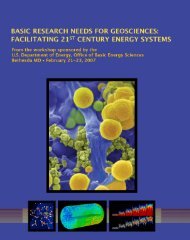Cyber Physical Systems â Situation Analysis - Energetics Meetings ...
Cyber Physical Systems â Situation Analysis - Energetics Meetings ...
Cyber Physical Systems â Situation Analysis - Energetics Meetings ...
- No tags were found...
You also want an ePaper? Increase the reach of your titles
YUMPU automatically turns print PDFs into web optimized ePapers that Google loves.
<strong>Cyber</strong> <strong>Physical</strong> <strong>Systems</strong> – <strong>Situation</strong> <strong>Analysis</strong>DRAFT – March 9, 2012Although greenhouse gas emissions are the highest in the buildings sector, according to some studiesthese represent the greatest potential for reduction of emissions, especially with the implementation ofnet-zero energy buildings. 164 It is important to consider that the largest carbon savings in the buildingssector by 2030 will come from retrofitting existing inefficient buildings. As buildings become moreefficient during their operation, the construction and disassembly of buildings will remain a significantproblem. The development of new building materials that have minimal environmental impacts is neededwhere recycled materials cannot be used. 165 Smart systems that improve building life or for manufactureof new building materials could play a role.Aging InfrastructureThe aging infrastructure of the United States‘ transportation system poses incredible technical andeconomic challenges, with bridges remaining a main concern. In 2008, approximately one in four of thenation‘s 600,000 bridges was structurally deficient or functionally obsolete, and the number of deficienturban bridges was increasing. The average age of a bridge in 2008 was 43 years. Most bridges are onlydesigned to last 50 years and were not designed for the increases in traffic volume that they areexperiencing today. Problems of congestion cannot be overcome unless bridges are expanded orrenovated to keep up with increasing volume of light and heavy vehicles. Yet the costs of constructioncontinue to rise, leaving challenges in how to fund the massive costs of new bridges. 166 CPS applicationscould help to accurately assess the health and safety of bridges, thus enabling more informed andeffective allocation of limited resources. New technologies that provide a better understanding of themaintenance requirements of infrastructure can even extend their useful lives. Smart bridge technologytoday is limited to groups of discrete sensors that provide limited knowledge about large and complicatedsystems. 167Health and SafetyThe collapse of the Interstate 35 West Bridge in Minneapolis on August 1 st , 2007 sparked a closer look atthe condition of the nation‘s bridges. Although there have only been about 47 deaths due to bridgefailures in the United States over the past 20 years, any bridge failure is viewed as unacceptable. 168Travelers often do not consider themselves at risk when crossing a bridge; they expect for bridges to befunctional and safe. CPS research can help ease the burden that states face in trying to keep up withmaintenance and help to ensure that there are no preventable accidents involving bridges.Natural disasters such as earthquakes, hurricanes, and flooding can also cause structural damage tobridges or buildings. Advances in CPS could provide the ability to determine the extent of damage thesestructures suffer after this type of event and could help to prevent collapses or other types of structuralfailure.In buildings where people are constantly present, such as homes, hospitals, schools, workplaces, andfactories, building occupant health and safety is a primary concern. Most people spend a majority of theirtime indoors, where the air quality can be poor compared to outdoors. As buildings become moreintelligent and energy efficient, conditions to support the occupants‘ health, safety, and productivityshould be maintained or improved. In fact, as building technologies are applied to achieve net-zero164 NSTC. ―Federal R&D Agenda.‖165 NSTC. ―Federal R&D Agenda.‖166 American Association of State Highway and Transportation Officials (AASHTO). ―Bridging the Gap: Restoring andRebuilding the Nation‘s Bridges.‖ Jul 2008.167 French, C. et al. ―Report on the NSF Bridge Workshop.‖168 AASHTO. ―Bridging the Gap.‖29
















